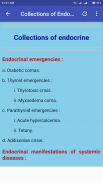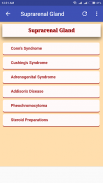












Endocrinology Basics

Description of Endocrinology Basics
The endocrine system coordinates functioning between different organs through hormones, which are chemicals released into the bloodstream from specific types of cells within endocrine (ductless) glands. Once in circulation, hormones affect function of the target tissues, which may be another endocrine gland or an end organ. Some hormones exert an effect on cells of the organ from which they were released (paracrine effect), some even on the same cell type (autocrine effect).
Hormones can be:
# Peptides of various sizes
# Steroids (derived from cholesterol)
# Amino acid derivatives
Hormones bind selectively to receptors located inside or on the surface of target cells. Receptors inside cells interact with hormones that regulate gene function (eg, corticosteroids, vitamin D, thyroid hormone). Receptors on the cell surface bind with hormones that regulate enzyme activity or affect ion channels (eg, growth hormone, thyrotropin-releasing hormone).
Endocrine disorders result from disruptions of the endocrine glands and/or their target tissues.
In this app we describe the basic endocrinal disorders.
Made easy for medical students preparing for exams.
Feel free to send us your questions or suggestions.

























